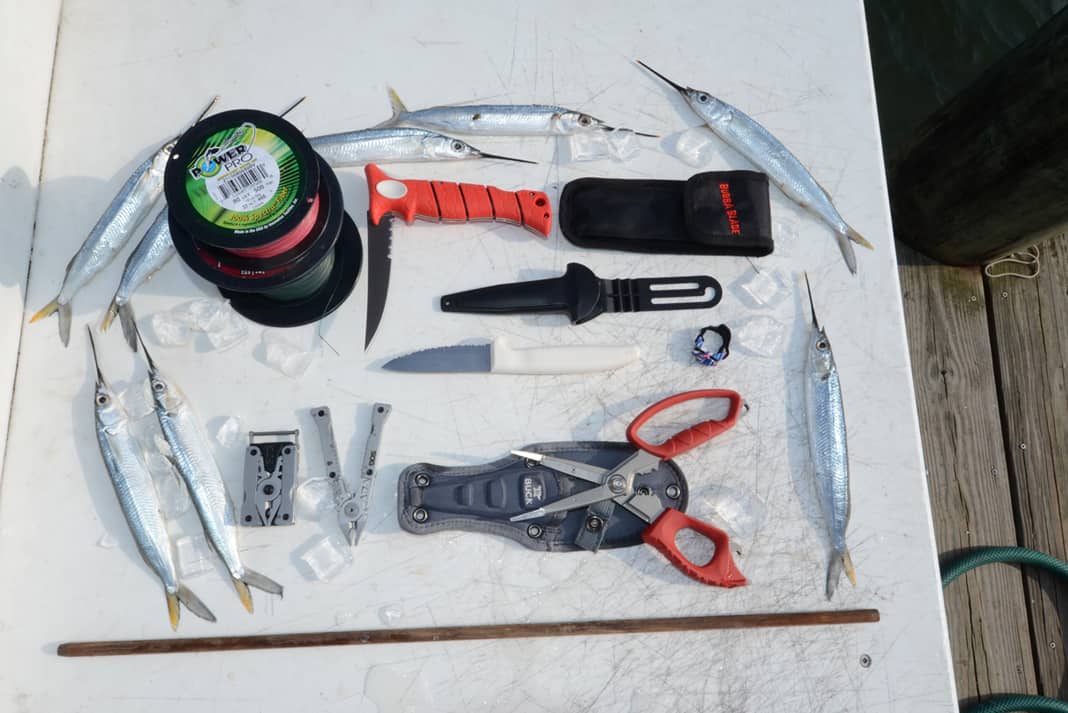Anglers require more tools than a race car mechanic. For the safety of the fish and fisherman, the right knives, scissors, pliers and lip grippers can save the day. Pack as many features on one tool and keep it close at hand. Consider using a tether if the tool is too valuable to lose.
Filet knives are sharp and pointy, not a good combination on a kayak. Back at the dock, the right filet knife makes quick work of the catch. Three blades will cover most applications. A long, thin filet knife removes the skin. A heavier, shorter, boner separates the meat from the bone. Hack through bone and thick skin with serrated knives.
Bait knives have a shorter, six-inch blade with a rounded tip for power cutting in a tight space. Use a folding knife or sheath to protect the blade when not in use. Pair with a small cutting board that’s easy to rinse and store.
Forceps are used for removing small hooks from little fish. The jaws lock onto the hook so the angler can wiggle it free. Also handy for tying small hooks onto light line.
Multi-Tools are a great compromise on the kayak. Keep one in the ditch bag for an emergency. Be sure to douse the tool with light oil. Wrap the multi-tool in a dry rag and drop in a resealable plastic bag.
A landing net scoops your catch into the kayak and keeps the fish from jumping out. Choose a net with a 20-inch hoop and rubber-coated webbing. A folding or collapsible handle makes it easier to store. Lie the net on the bow, without tangling rods, hooks or rigging.
Nippers are sharp, short cutters with power to snip wire and fishing line close to the knot. Nippers work great to remove a hook. Push the point and barb through the skin, use the nippers to cut off the tip then back the hook out.
Pliers have a million uses. From removing a hook to tying knots to tightening bolts or opening a bottle, needle-nose pliers come in handy when fingers can’t get the job done. Pliers with replaceable jaws and cutting blades will last longer. Keep the pliers coated in light oil and store wrapped in a dry rag.
Rulers and tapes add an element of truth to the wildest fish story. Catch-photo-release tournaments introduced anglers to bump boards: plastic measuring boards with a panel at the 0-end. Line the fish’s nose on the panel and hold the tail flat to take the measurement. Many paddles have a ruler embossed on the shaft or use a permanent marker to draw your own measurements. We trust you.
Scales are at best only slightly accurate on a rocking kayak, but a hand held digital model is most reliable. Some lipgrippers include a spring scale for a ballpark weight. A hand scale is handy to set drag pressure.
Tethers and Retractors keep tools and gadgets from going overboard. Connect tethers to your life jacket and dangle forceps, pliers and other small tools. Also, use a tether to connect a pealess signal whistle to the PFD.
Leashes offer peace of mind when taking expensive gear on the water. But attaching a leash adds weight and makes it hard to operate the rod or paddle. Also, if the kayak flips over, the angler could get tangled in ropes and leashes. When anchored in swift water, it’s a good idea to keep the paddle on a leash so it won’t drift away if it goes overboard. A rod leash with quick release is valuable when fishing heavy seas. To transport rods through the surf zone, either load them inside the kayak or use a strong bungee across the reels to keep them in the vertical rod holders.
Utility knives make quick work of small cuts. Choose a folding blade with a belt clip to attach to a life vest pocket.
Choose the right blade for the job. Featured Photo: Ric Burnley
